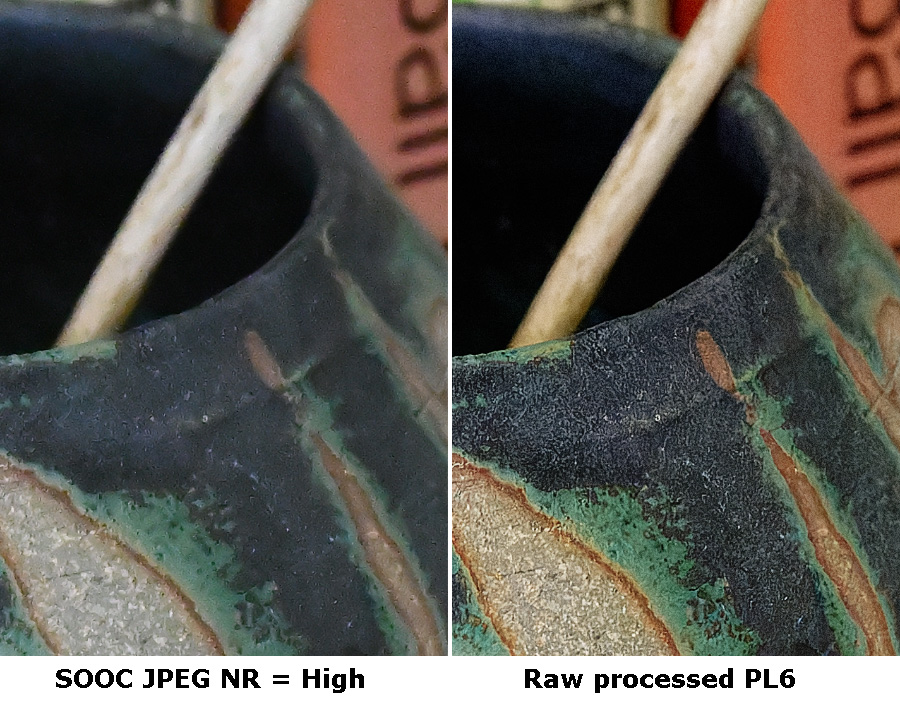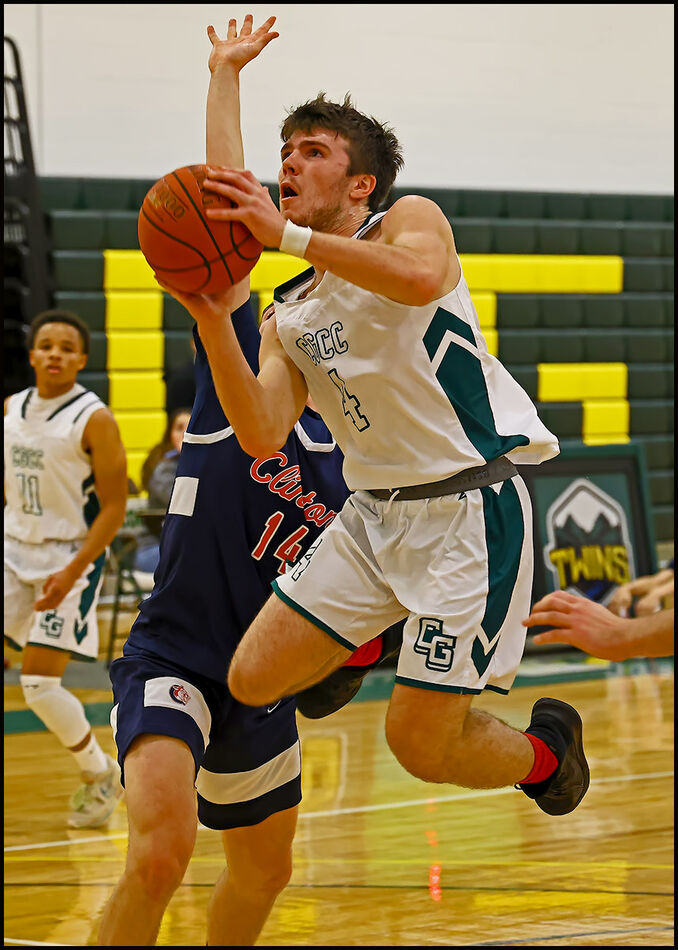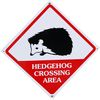High ISO Noise Reduction
Dec 14, 2022 08:44:52 #
Now that Covid is not so prevalent I have been able to return to shooting basketball games at the local college. I have noticed that IQ has dropped slightly. The photos aren't bad, by my standards anyway, but when brought up to 100% they have a distinct blurriness that hadn't occurred previously. Aside from a different camera, an R5 instead of an R, I have been experimenting with different lenses. Still, with my usual lens, an RF 85mm F/1.2 L, and usual settings the results have been distinctly different then before. The one big difference has been the use of the High setting for noise reduction. I selected that at the first game when I was using an f/4 lens because of the higher ISO required and never set it back. I shoot the games in JPEG, BTW. I give all the photos to the athletic dept, after deleting a large (huge) percentage of them, so JPEG works fine. I became suspicious of the High setting so when my nephew, a former pro photographer stopped in yesterday to show me his latest $10,000 Nikon lens I mentioned it to him. He laughed and said "Blurs it, doesn't it?". So there you have it. I wasn't aware of that aspect of noise reduction. Has anyone else run into this issue?
https://www.uglyhedgehog.com/t-759347-1.html
https://www.uglyhedgehog.com/t-759347-1.html
Dec 14, 2022 08:55:10 #
Ysarex
Loc: St. Louis
LFingar wrote:
Now that Covid is not so prevalent I have been abl... (show quote)
In-camera noise reduction sucks. There's a reason for that. Noise reduction is processor intensive and the camera image processing software can't afford the time required to do even a half-a**ed poor job of noise reduction. If you still want the camera to be able to shoot X frames per second then you're trading that ability against the quality of the processed output. Below is a side by side comparison of Nikon's High NR (Z7) with a 12K ISO shot versus DXO PL6 processing the raw file.

Dec 14, 2022 08:57:27 #
Personally, I choose not to use in camera noise reduction. Instead I do it in post processing. I have found noise reduction does soften the image a bit. Especially if overdone. By doing it myself, I can find a level that i acceptable to ME. My tool of choice is Topaz Denoise AI. You can download and use a copy free for 30 days to see if you like it.
Dec 14, 2022 09:01:28 #
LFingar wrote:
Now that Covid is not so prevalent I have been abl... (show quote)
Are you thinking a camera, even superior Canon EOS technology, can run a noise reduction algorithm that is superior to selective masking, selective sharpening, and the AI-enabled Noise Reduction tools like Topaz? All in a subsecond of processing in a burst of images?
I looked at your link. Yes, the thumbnails look great. The attachment at the pixel-level doesn't hold up so well. Here's a great situation to resize your images to say 2048px on the long-side if these types of images are for display purposes only. Recommended resizing parameters for digital images
To counter-act the loss of details from the camera's High ISO NR, consider your in-camera sharpening settings, where advanced cameras are now offering some amount of detail-level sharpening. It may not be perfect, but you may find you can get slightly better results.
Consider too your JPEG processing flow. Are you already processing these images in post? If you stop the in-camera NR, do you have a batch tool on your desktop computer that could do a better NR job without elongating your workflow? Something that runs in batch with effective defaults that are an overall better result than the camera, without being cumbersome and time consuming?
Dec 14, 2022 09:44:48 #
Thank You to those who have responded. You have effectively answered my question about in-camera noise reduction, a feature I have rarely used and don't plan on using in the future. Under current circumstances, with a fast lens, the ISO stays low enough that I don't need it anyway. In a gym I usually shoot in Manual but leave the ISO in Auto. With the f/4 lens the ISO got quite high which is why I tried the higher noise reduction setting. I do minimal, if any PP since I give the photos to the college. They process as they wish and even these lesser IQ ones are fine for their purposes.
Dec 14, 2022 09:48:04 #
First thing first, I am a Nikon shooter, I have been for over 55 years. The Canon R5, from what I know tends to show noise even at ISO 800, even if shooting RAW data, that is what has been reported by other photographers. Obviously, I have no experience with Canon cameras, I am only repeating here what I have read in the past and what I know.
Many modern cameras have a setting for noise reduction, others apply a small amount of noise reduction when the ISO is set high. Usually they do that automatically since the noise reduction is built into the software of the camera. You will have to experiment a little bit before settling on what is best for your style of shooting but if I had something to recommend you it would be to set the noise reduction off. The noise can be controlled very successfully with a good noise reduction program such as Topaz Denoise AI. I still use their original version 6 which has worked nicely for me in those rare occasions when I shoot at very high ISO settings. The software that I use has a blur and recover details controls and I have learned how to manipulate them in subtle ways to bring back sharpness. As a rule and for most of the images I edit with the software it cleans the noise without been aggressive on sharpness when using low settings.
A 100% view of an image is quite a large enlargement, larger than a 20x30 inch print. What I am saying is that you do not have to be very aggressive with noise reduction to have a great image. I looked at the images in your link and they look very acceptable to me.
If after experimenting with the camera keeping high noise reduction off and in post using a good noise reduction software you still experience bothersome noise you could contact Canon and discuss the problem with them for further advise. By the way, I worked with one of the images that you shot at ISO 5000 and applied a small amount of noise reduction Then I played with the two controls I already mentioned. It cleaned the noise without affecting adversely the quality of the shot.
Useless to say that if a lower ISO setting yields the results you want then you should go that way.
Many modern cameras have a setting for noise reduction, others apply a small amount of noise reduction when the ISO is set high. Usually they do that automatically since the noise reduction is built into the software of the camera. You will have to experiment a little bit before settling on what is best for your style of shooting but if I had something to recommend you it would be to set the noise reduction off. The noise can be controlled very successfully with a good noise reduction program such as Topaz Denoise AI. I still use their original version 6 which has worked nicely for me in those rare occasions when I shoot at very high ISO settings. The software that I use has a blur and recover details controls and I have learned how to manipulate them in subtle ways to bring back sharpness. As a rule and for most of the images I edit with the software it cleans the noise without been aggressive on sharpness when using low settings.
A 100% view of an image is quite a large enlargement, larger than a 20x30 inch print. What I am saying is that you do not have to be very aggressive with noise reduction to have a great image. I looked at the images in your link and they look very acceptable to me.
If after experimenting with the camera keeping high noise reduction off and in post using a good noise reduction software you still experience bothersome noise you could contact Canon and discuss the problem with them for further advise. By the way, I worked with one of the images that you shot at ISO 5000 and applied a small amount of noise reduction Then I played with the two controls I already mentioned. It cleaned the noise without affecting adversely the quality of the shot.
Useless to say that if a lower ISO setting yields the results you want then you should go that way.
Dec 14, 2022 09:59:06 #
jackpinoh
Loc: Kettering, OH 45419
In-camera noise reduction reduces noise throughout the frame, reducing contrast across multiple pixels. This works great where noise is a significant change in pixel value over the pixel value in its neighborhood, bit it also reduces contrast at edges (more apparent in in-focus areas), making the image appear soft. That is why post processing noise reduction is better. I select those areas where noise is most apparent, like the sky, out of focus background, and in-focus areas that lack detail, and apply noise reduction only to those areas, avoiding highly detailed areas. I do not apply noise reduction on detailed in-focus areas, On detailed in-focus areas, noise serves to enhance texture and is hard to detect. I suspect the algorithms in DxO Prime, Topaz Sharpen AI, etc. do something similar.
Dec 14, 2022 10:02:03 #
Having shot sports professionally for the past over 48 years, I just never use in-camera high ISO NR, it sucks in all brands. Everyone else has explained why.
Cheers and best to you.
Cheers and best to you.
Dec 14, 2022 10:53:56 #
LFingar wrote:
Now that Covid is not so prevalent I have been abl... (show quote)
Blur ? Is that loss of detail ? Soft edges ?
I often use high iso NR and while all cameras lose detail, some cameras manage to keep a good edge to things and others do not. So yes Ive noticed the *cost* of high iso NR, otherwise I would not have noticed that difference.
I dont miss the missing tiny details but I must have sharp looking edges on most important shapes. What is "sharp looking" may look imperfect under pixel peeping but I only care about what looks sharp in the context of the whole image.
~~~~~~~~~~~~~~~~~~~~~~
You mentioned "IQ". I dont judge the technical quality of image as a measure of the success of the image. Acoarst *some* images certainly do require technical excellence for their success.
Dec 14, 2022 11:40:17 #
larryepage
Loc: North Texas area
LFingar wrote:
Now that Covid is not so prevalent I have been abl... (show quote)
One of the things about photography that is most attractive to me is its versatility...it is useful as a recorder of events, a capturer of memories, a creator of visuals for training, a creator of fine art, a documenter of inspections (of property, for instance), a recorder of surveillance activity, and a vehicle for being able to see the otherwise unseen. Like many folks, I have used it for many of these functions, sometimes for more than one at the same time. Photography has many features, functions, and aspects. Some are more useful than others for its various uses. Some are irrelevant to some of them.
Serious, directed photography was initially a peripheral activity for me. Approaching 60 years ago I was working on a science fair project, and I needed to document and display the physical construction of the internals of various transistors and other semiconductor devices. So starting from and building on my experience photographically recording our family vacations, I learned about extension tubes and lighting and color correction filters to do just that. The discovery that I could move beyond ordinary snapshots then moved me into photography with very limited available light and then photography of things that were otherwise too dark to see in ordinary circumstances.
My point here is that it is interesting that we as photographers use capabilities of our cameras that were put there for one purpose to accomplish completely different purposes. One example of that is the increasingly high ISO capabilities built into our cameras. If you investigate, you will come to realize that high sensitivity capability is put there primarily for the benefit of one group of camera users (and reliable paying customers)...those doing photographic surveillance. Those are the folks who can reliably and beneficially make use of the ability to operate at ISOs of 12,00 or 25,000 or even higher to do things they can't accomplish any other way, and will reliably pay money in large numbers for the capability. They usually don't care about loss of dynamic range at those levels, nor loss of color rendition, nor the presence of some noise in the images. They can get the shot that they could not get before, and they can do it with less obtrusive lenses that call attention to their activity.
As to High ISO Noise Reduction...I don't know about your camera, but my cameras all provide an option to use it at less than full throttle. I had a favorite aunt who had several life mottos. One of my favorites was, "All things in moderation, even excess." I use noise in-camera noise reduction frequently. But almost never with the gas pedal pressed all the way to the floor. Less usually works better and provides what is needed. After all, do you always slam the sliders all the way to the right when you do post processing? Just because it doesn't work well when turned all the way up doesn't have to mean that it is useless.
Second...remember that noise reduction is tasked with removing noise from your image. It has to remove what was replaced with something. Otherwise it leaves a blank pixel behind. There are several ways to choose what to put in the hole. If all the surrounding pixels are the same (or about the same), it wil usuallu just replace the hole with the value of those pixels. If they are different, then the software has to make a choice. It has to "make something up." That's when the trouble starts. Even "good" software isn't going to always get it right.
Finally...as I have worked with folks using high ISOs, I have found that more than probably 90% of the time, despite using the high ISOs, they are still underexposing their images. Don't do that. Noise happens when a system thinks it has to fill in a gap that is empty. Make sure that your shots are fully exposed.
This is probably a lot more than you were asking for, but maybe it will give you some food for thought moving forward.
Dec 14, 2022 20:31:33 #
Once again, Thanks everybody for your replies. Some good points were made.
Dec 15, 2022 09:56:10 #
LFingar wrote:
Now that Covid is not so prevalent I have been abl... (show quote)
No but you made look into this and check what option I had it set to or came from the factory. It is only used aka applied when using JPG. If raw it only goes into the meta data and not photo. Here is a fairly solid video on the topic for the R5. All the rationale you may nor may not care about!
https://www.youtube.com/watch?v=fztZOjr5wrg
Dec 15, 2022 12:48:41 #
Ysarex wrote:
In-camera noise reduction sucks. There's a reason for that. Noise reduction is processor intensive and the camera image processing software can't afford the time required to do even a half-a**ed poor job of noise reduction. If you still want the camera to be able to shoot X frames per second then you're trading that ability against the quality of the processed output. Below is a side by side comparison of Nikon's High NR (Z7) with a 12K ISO shot versus DXO PL6 processing the raw file.
Great feedback and explanation! Thanks
Dec 15, 2022 13:05:03 #
LFingar wrote:
Now that Covid is not so prevalent I have been abl... (show quote)
All types of noise reduction reduce image quality! Best to turn it off in-camera and do it in post where you have some control over the process.
bwa
Dec 17, 2022 17:29:34 #
rcorne001 wrote:
Personally, I choose not to use in camera noise reduction. Instead I do it in post processing. I have found noise reduction does soften the image a bit. Especially if overdone. By doing it myself, I can find a level that i acceptable to ME. My tool of choice is Topaz Denoise AI. You can download and use a copy free for 30 days to see if you like it.


If you want to reply, then register here. Registration is free and your account is created instantly, so you can post right away.







